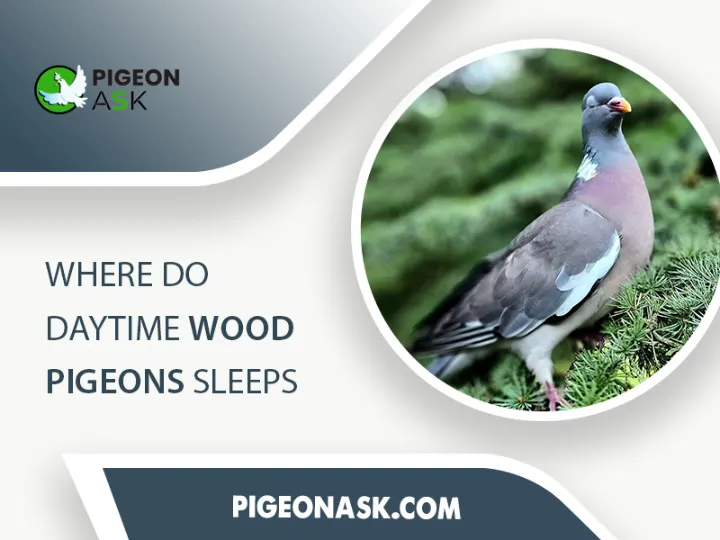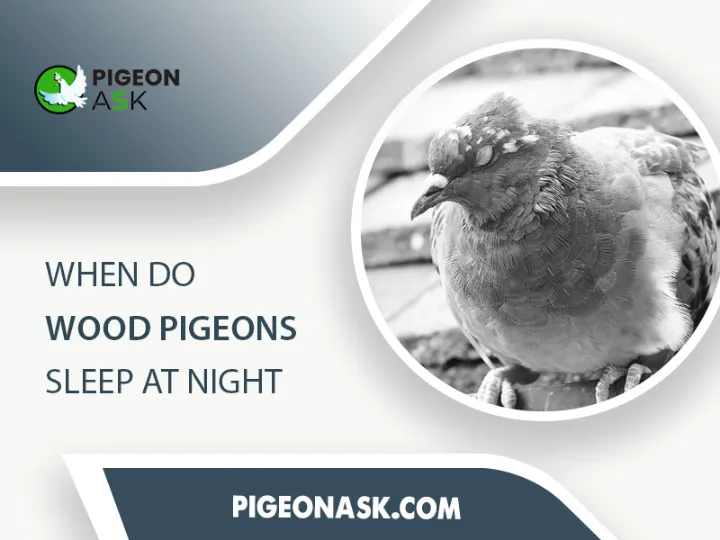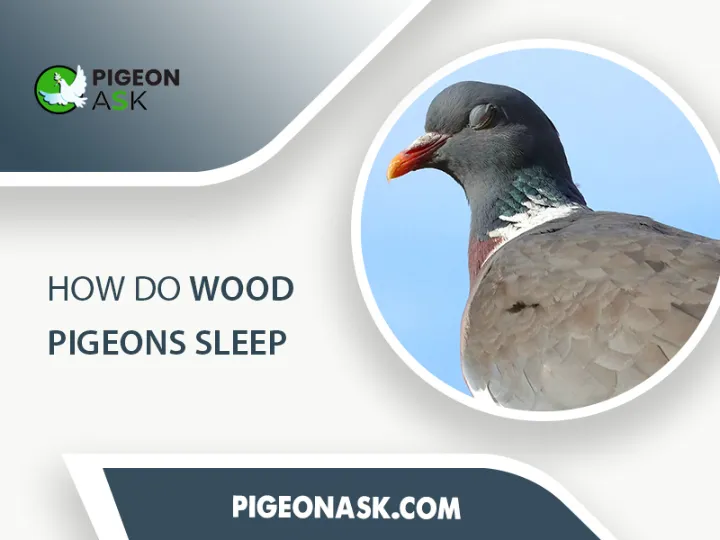Where Do Wood Pigeons Sleep at Night?
Have you ever wondered where do wood pigeons sleep at night? As daylight fades, these birds gracefully ascend to the elevated branches of trees, forming a communal haven in nature’s embrace.
The choice of their lofty roosting spots is not arbitrary; wood pigeons often seek out sheltered locations with dense foliage, providing both protection and warmth.
Their preference for tall trees not only serves as a vantage point against potential predators but also offers a secure spot to rest during the night.
Let’s explore the simple yet fascinating world of wood pigeons, discovering the reasons behind their chosen sleeping spots and more.
Where Do Daytime Wood Pigeons Sleeps?
They are often found on buildings or other elevated structures at night, but during the daytime, things are different.
Wood pigeons take advantage of the natural cover provided by trees and dense vegetation to rest and recover from predators.

Their ability to adapt is shown by their dual roosting pattern, which allows them to blend in with both urban and natural environments.
Despite the popular notion that wood pigeons only roost in trees, wood pigeons have occasionally been seen sleeping on the ground during the day.
Where Do Wood Pigeons Sleep at Night?
As the sun sets and the moon rises, wood pigeons take flight in search of a comfortable place to spend the night. During the breeding season, when they are busy finding mates, they prefer to sleep in pairs, nestled in the trees or bushes.
But once the breeding season is over and parenting duties begin, wood pigeons become solitary nesters, searching for the perfect spot to rest.

As night falls, these nocturnal birds start looking for a ledge that meets their needs. They prefer the lower levels of buildings, as long as they are flat and sheltered from the wind and rain.
And they seem to have a checklist they follow to find the perfect spot: “Is it flat? Does it provide enough shelter?” Once they find a suitable location, they settle in for the night.
Next time you take a stroll through the city at night, remember the wood pigeons who call it home. They have adapted to urban life and found their own unique way to make the most of their surroundings.
Why Do Wood Pigeons Sleep at Night?
Wood pigeons’ nighttime behaviors are impacted by a variety of biological, environmental and adaptive factors. The following are possible explanations for why wood pigeons hibernate at night –
Diurnal Nature
Being a diurnal species, wood pigeons are active during the day and sleep at night. Their bodies have adapted to this cycle and their diurnal behavior is a component of their natural biological pattern.
Avoiding Predators
Wood pigeons that sleep at night have a brief window of lessened vulnerability to predators. During the day, a lot of its natural predators, including raptors, are more active. They are able to evade possible dangers when they sleep at night.
Environmental Temperature
They are able to maintain body temperature and conserve energy during their nocturnal snooze.
Particularly in untamed or open spaces, nighttime temperatures can plummet. Thus, sleeping through the colder hours helps avoid using too much energy.
Social Conduct
Since wood pigeons are gregarious birds, they feel more secure when they sleep together at night. They can keep an eye out for predators as a group while they sleep together and other people’s presence can act as an early warning system.
Nesting Behaviors
The primary purposes of wood pigeon nests are nest-building and egg-sheltering.
After dusk, the nests cannot offer the protection they need, so they investigate other potential roosting locations, such as tall structures, trees, or thick vegetation.
Circadian Rhythms
Wood pigeons have inherent circadian rhythms that affect their sleep-wake cycles, just like many other animals do.
Light and darkness, among other things, have an impact on these rhythms, which assist in controlling their everyday activities, including sleep.
Energy Conservation
These birds are less active at night, which gives them time to store energy for the rigors of the next day. Foraging and other nighttime activities become less necessary, which improves overall energy efficiency.
Reproductive Action
The reproductive cycle of wood pigeons may have an impact on when they sleep.
They may modify their sleep schedules throughout the breeding season to meet the demands of daytime mating, courtship and child-rearing.
When Do Wood Pigeons Sleep at Night?
Because wood pigeons are nocturnal species, their nighttime routine coincides with the arrival of night. As the day draws to an end, they usually start to settle down at dusk and find their preferred roosting locations.
The timing of wood pigeon sleep onset can vary based on environmental factors, with some individuals choosing to roost earlier or later depending on local conditions.
You can read our article about “Pigeon Habitat“
Do Wood Pigeons Sleep in Their Nests?
You would think that the warm, well-constructed nests that wood pigeons build for themselves are where they spend the night.
But in reality, they do not spend the night in its nest. Mostly, wood pigeons utilize their nests for nest-building and egg-sheltering; when night falls, they look for other places to stay.
These birds have been seen to use their nests as makeshift social hubs during the day when they are not sleeping together.
Do Wood Pigeons Sleep on Buildings?
Wood pigeons have adapted to the concrete jungles created by urban landscape expansion, taking refuge atop man-made structures. These birds frequently spend the night atop structures, perched on ledges, windowsills, or other raised areas.
They have a safe and cozy place to sleep, thanks to the warmth. Moreover, they may exhibit a preference for roosting on reflecting surfaces or heavily inhabited metropolitan structures, perhaps due to the extra warmth and camouflage.
Do Wood Pigeons Stay Alone in the Night?
Well, they are thought to sleep alone, yet they frequently engage in group roosting. These gregarious birds like to sleep in flocks, which helps to provide a feeling of warmth and security at night.
The cooing sounds that might seem solitary during the day transform into a symphony of communal rest as night descends.
Some experts argue that communal roosting in wood pigeons may be not only a defense against predators but also a form of social bonding, challenging the traditional notion of birds as individualistic creatures.
How Do Wood Pigeons Sleep?
Wood pigeons have a unique sleeping position that lends elegance to their nocturnal slumber. It is well known that these birds sleep with their legs propped up, a habit that is shared by many other bird species.

In addition to preserving body heat, the tucked-in leg highlights how adapted wood pigeons are to their surroundings.
According to several ornithologists, wood pigeons’ one-legged sleeping stance could function as a thermoregulatory system, enabling them to regulate their body temperature throughout the night.
Frequently Asked Questions
Do wood pigeons have a specific bedtime routine?
Wood pigeons exhibit a gradual transition to their elevated roosts as dusk sets in, marking the beginning of their nighttime rest.
How do wood pigeons choose their sleeping companions in a roost?
They often roost in groups, creating a sense of safety and warmth through communal sleeping arrangements.
Are there variations in wood pigeon sleeping habits based on seasons?
Wood pigeons may alter their roosting patterns seasonally, adapting to changes in weather and daylight duration.
Do wood pigeons experience interrupted sleep, and if so, how do they handle it?
Yes. Like many birds they can rest with one eye open, allowing for a level of vigilance even during sleep.
How do wood pigeons find their way back to their preferred roosting spots each night?
Wood pigeons rely on their keen memory and visual cues to navigate back to familiar roosting locations, showcasing their remarkable spatial awareness.
Conclusion
When we investigate the complexities of wood pigeons’ sleeping patterns, we find a rich tapestry of behaviors that not only demonstrate how they have adapted to their natural habitat but also shed light on the interesting parts of bird life.
These behaviors range from bedtime routines to the social dynamics that occur within their nighttime retreats.
